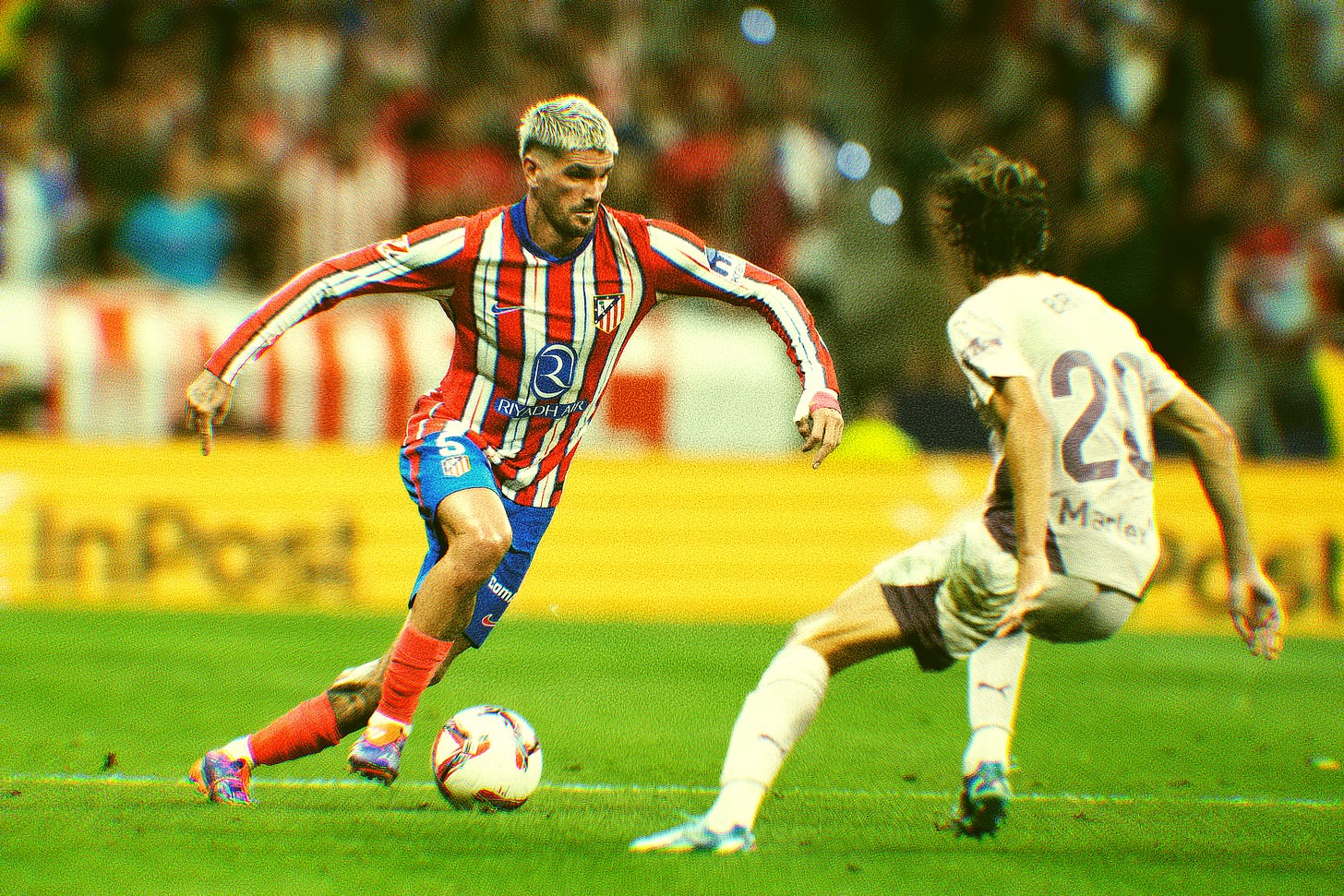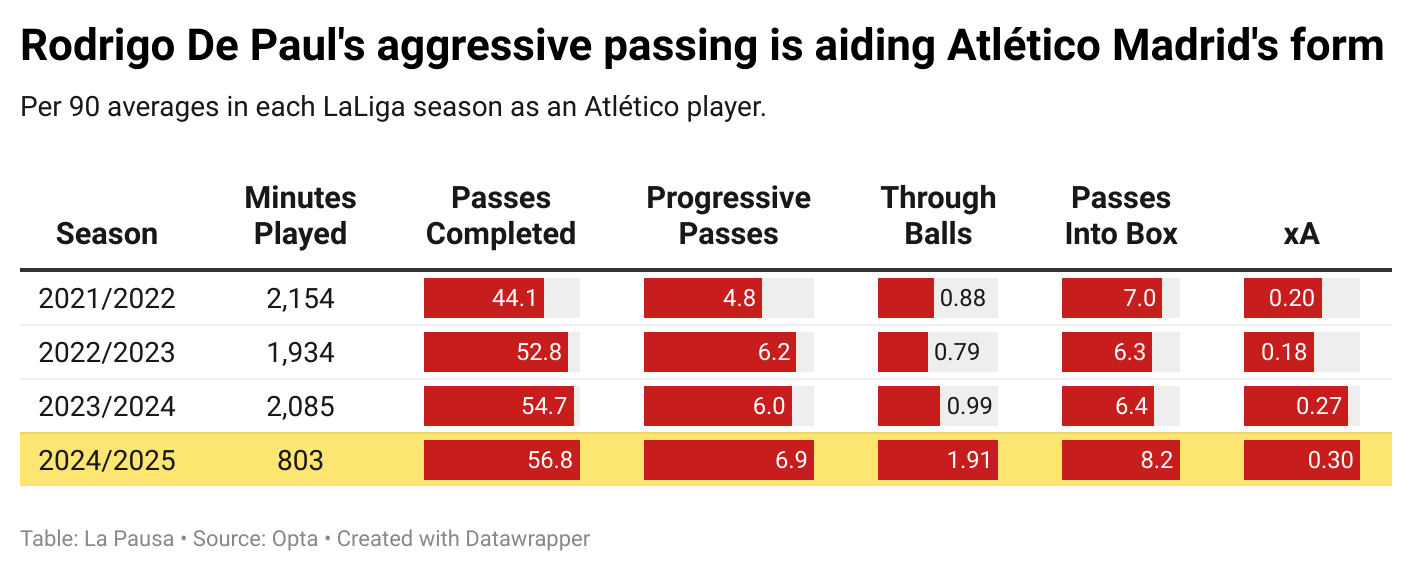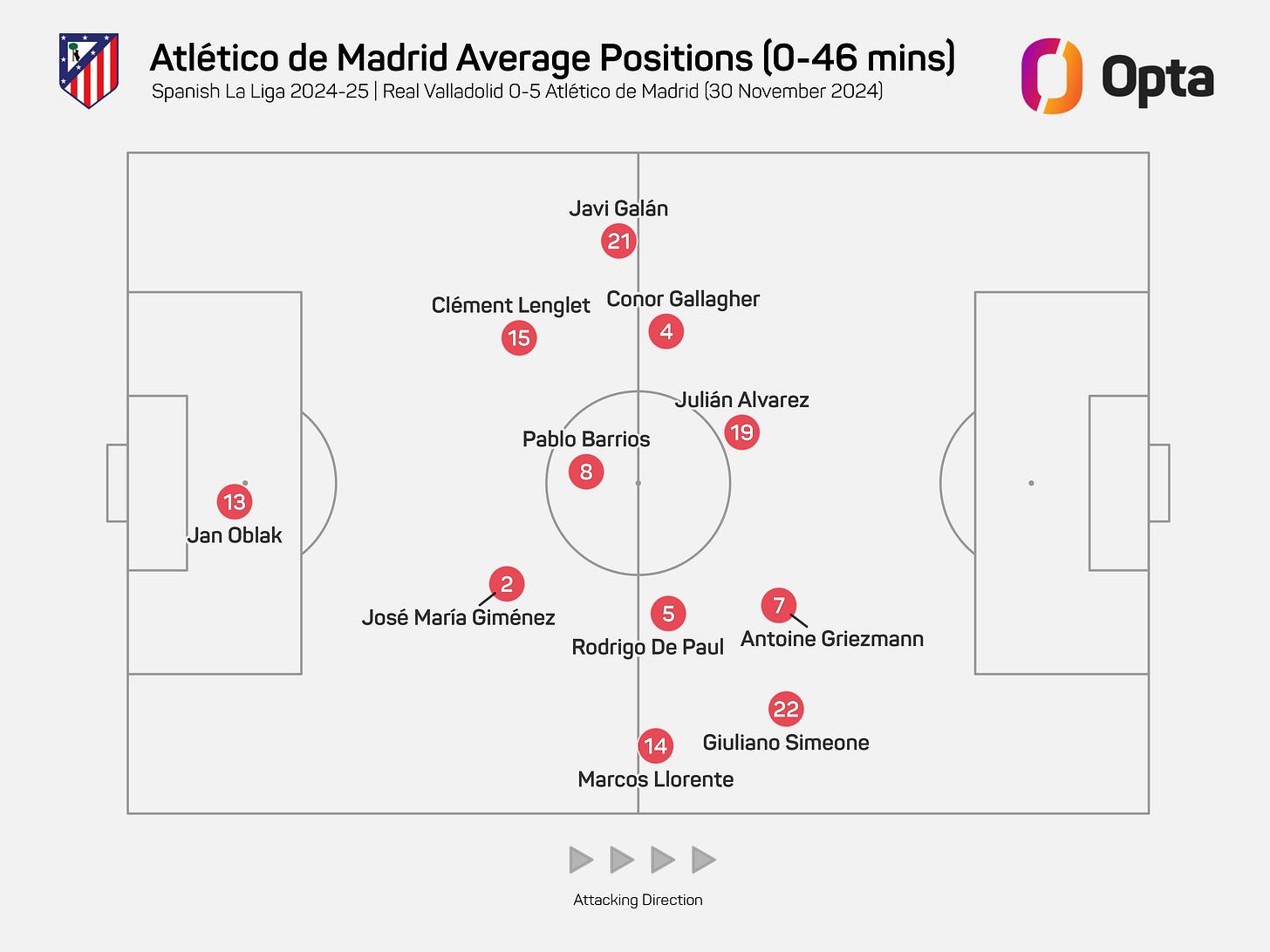The time is now for Rodrigo De Paul
In what is his fourth season at the club, the Argentinean's risk-reward approach to distribution has more of a function than ever for Atlético.
Signed in the summer directly following their last title win in 2021, Rodrigo De Paul was a marquee signing for Atlético Madrid. Taking advantage of being the then champions of Spain, the club were able to scoop up a player who had been among the top creators in European football the previous campaign, right as he was about to enter the prime years of his career.
In what is now his fourth season at the club, things haven’t exactly played out as both would have hoped back in 2021. De Paul was one of the big bets the club made in the wake of their title win, and someone who was expected to be a pillar of a team who would fight to remain in trophy contention in coming years. However, Atlético haven’t won a trophy in his time at the club, and the Argentinean has struggled to consolidate his role in a team that have since strained in their pursuit of honours.
Of course, De Paul has had huge success at international level in the same time. A World Cup and Copa América winner, he has played a significant role in a team who have been ranked number one in the FIFA rankings for almost two straight years. Along with the accolades, his position as Lionel Messi’s right-hand man earned him huge attention across the sport. His profile in the wake of the 2022 World Cup, compared to what it was back in 2021, transformed dramatically in the process.
Between that jarring difference in club and country, De Paul’s standing in Madrid has been difficult – especially difficult on certain occasions. Fans wonder why a player who’s contributed so much to international success has struggled for consistency with Atlético, and why his importance with the sport’s most successful nation seems to evaporate at club level.
The potential explanations for that are endless. But regardless of whether it’s a struggle to diagnose the problems, or a problem of not being able to address them once established, the reality is that finding the remedy has evaded Atlético Madrid season after season.
Perhaps, until now.
Embracing De Paul’s daring distribution
One of the big complaints against De Paul, specifically during periods of struggling form, is his looseness with the ball. Quite simply, the 30-year-old makes it pretty easy for an irked supporter to identify when he’s having an off-day.
Where others dial back the potential risk of their decisions during periods of difficult form, De Paul is an outlier who stays on his natural path. Even if he misplaces two passes in a short period of time, his willingness to play a riskier pass on the next occasion is just much higher than that of the average player. That makes him prone to the groans of the crowd, and exacerbates the sense of sloppiness invading his game. Many times, there’s little defence against it.
On the flip side, however, the Argentinean’s mentality makes him unique in the Atlético squad. Even if you struggle to look past his — at times — inefficient play, De Paul’s upfield vision is still a huge asset among Diego Simeone’s weapons. With the exception of Antoine Griezmann – who you ideally want to be finishing as much as creating – nobody attacks game-altering passes with the aggression and quality that De Paul does. The question has just always been about how Atlético can get most out of it, where the advantages overbear the associated risks.
In the first half of the 2024-25 campaign, the sense is that they might now be closer to solving that than ever. Indeed, rather than pull back, and rather than dimming down his intent in place of heightened efficiency, we are seeing De Paul being more aggressive than ever with his distribution — all of which has been to Atlético’s gain.
What’s occurring this season is that the factors surrounding De Paul are beginning to line up to his natural game – at least, certainly more than they have in previous seasons. With that, the Argentinean is benefitting from a context that is more compatible with his default style, while Diego Simeone’s side are profiting from his unique quality of distribution in return.
Particularly since Atlético’s return to the 4-4-2 system, the distribution of players on the pitch — as well as the profile of said players — has enhanced the conditions for De Paul’s punchy passing game. The crucial aspect that underlies everything, however, is the fact this version of Simeone’s side are incredibly active in attack. Their movement ahead of the ball is generous, and the players who are doing so are athletic to boot. Julián Álvarez runs hard and smart, Antoine Griezmann recurs in the same way, Javi Galán and Marcos Llorente fly from full back, Giuliano Simeone is a relentless runner, and the mobility between Alexander Sørloth and Ángel Correa off the bench has been a solution all season long.
Logically, the 4-4-2 shape morphs a lot during the phase of the game — largely in part to give rise to the aforementioned players. Specifically when Atlético set themselves up in the opposition half, their base is often made up of the two centre backs and their two central midfielders. For De Paul, that means plenty of space to get on the ball in deeper areas and see plentiful options once he lifts his head.
We can see that in practice below, from their 1-0 win against Getafe last time out. With right back Llorente high up the pitch, and right winger Simeone tucked in, Atlético clear out the space for De Paul to face the game up and assess the options ahead of him. In this team, that means go time for runners. And on this occasion, it’s Samuel Lino obliging the moment De Paul opens out.
Indeed, the switch from 3-5-2 to 4-4-2 now makes the run from Lino — who would have been closer to the touchline a few months ago — a viable one. Instead of three centre backs and one holding midfielder, Atlético can now initiate with two centre backs and two central midfielders; one of which being a key progressive aid in De Paul, who can produce dangerous passes from all over the field.
Here against Real Valladolid, it’s a similar formula. Atlético hold their usual four players at or behind the line of the ball, while those ahead mix up their movements to attack the defensive line. For De Paul, it is Marcos Llorente who makes the compelling run this time, launching his movement as soon as his teammate gets hold of the ball. And with a better end product from Llorente, Gallagher’s own response to De Paul’s upfield gaze might have earned them another goal.
And another one, this time against Alavés. That’s an Alavés side — by the way — who were defending with a back six by this point of the game. No doubt a preparatory measure to keep track of Atlético’s runs beyond the last line, as they clung onto a point for dear life.
Unfortunately for them, De Paul was soon to find his next recipient. Back in his familar right-sided role with players ahead ready to present their movements, this one required a quick shift of frame to take Ander Guevara out of the picture, before sliding in Alexander Sørloth’s well-timed run to produce the winning goal.
While Atlético have super-charged their mobility in the opposition half — much to De Paul’s liking — they are proving to be a well balanced team on both sides of the ball at the same time. Their setup in attack and the improved possibilities for De Paul to make his passing game count haven’t come at the expense of defensive frailties or breakdowns when possession changes hands. They have the best defensive record in LaLiga, if you factor in xG along with actual goals conceded.
For now, Diego Simeone’s side have settled on a way of playing that’s providing balance and tapping into the attributes of the squad. In the case of Rodrigo De Paul, that has meant involving him early on in their sequences of possession, creating space for him to play by filling and stretching the pitch ahead of the ball, and then using those same players as the end points for the Argentinean’s vision.
Though Atlético still do plenty of hunkering down on the defensive end, the relationship between attacking better and defending better is undoubtedly at play here too. In that respect, it’s interesting to note that they have maintained their league-leading defensive performance while being without Robin Le Normand — one of Spain’s best defenders and undoubtedly their best — since the start of October. Though they’ll inevitably welcome him back, Simeone’s side haven’t notably suffered or had to rely on heroic performances from José Giménez or Clement Lenglet.
In that increasingly stable environment, it has only served to encourage De Paul’s already-expansive passing game. He is averaging just under two through balls per 90, which is almost twice as many as the player with the next most in LaLiga this season, in the form of Dani Olmo. Indeed, De Paul’s average is the highest of anyone across Europe’s big five leagues this term too.
As you can see from the table above, De Paul’s use of the ball is more like something you’d expect from a no. 10 than an orthodox central midfielder. His current midfield partner Pablo Barrios completes 88% of his passes, whereas the Argentinean is closer to Dani Olmo in aggression/efficiency than he is his Atlético sidekick.
It’s the simple relationship between intent and retention — the riskier passes you make, the more you will cough the ball up. Rodrigo De Paul has never seemed to take issue with that reality, even in his most precarious moments as an Atlético player. In fact, what has hurt his standing at the club in the past is now much of what is driving his latest renaissance. De Paul has doubled down, and he’s making great use of the green light that the team’s new composition is affording him.
As he approaches the back nine of his prime years, and with three seasons already behind him, we’re now firmly into the better late than never territory for De Paul in Madrid. The window to change him as a player is gone, but changing the world around him might just provide the click.








